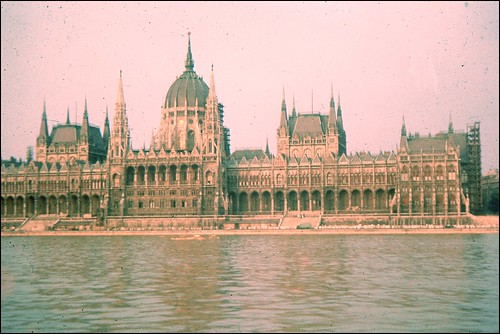
Can you see the red star on top?
Check more of these pictures on Simon_K’s flickr page.


Hungarian Jewish Travel Site
You can see her from almost anywhere in Pest. Originally, she was the Soviet Liberation Monument and was guarded by a Soviet soldier from a lower pedestal. He, with a machine gun and a hammer-sickle flag is now in the Statue Park, together with Lenin and others. She could stay, since the 90’s we call her the Statue of Liberty. Watch how she was test-assembled.
Rakosi was one of the communist leaders of Hungary in the ’40s and ’50s, the worst example of personal cult in Hungary was presented by him.
Sixty years ago, on March 9, 1952, a grandiose exhibition was opened in the former Budapest Palace of Justice – today the building of the Museum of Ethnography – on the occasion of the 60th birthday of Matyas Rakosi. On display were gifts made for Rakosi to celebrate the event, including a large number of handicrafts by Hungary’s folk artisans.
The museum opened today an exhibition on the sixtieth anniversary of the 1952 exhibition in the hope of prompting further research on the subject, using material from the collections of the Museum of Ethnography and Hungarian National Museum to explore this unusual “star exhibition” from the building’s past.
Crowds visiting the exhibition organized in 1952 to celebrate Rakosi’s 60th birthday:


Everybody had to celebrate. “Presents” were arriving from the whole country to the “wise leader” Women embroidered for him: to Comrade Rakosi on his 60th birthday:

Photos from neprajz.hu
Watch the TV reports about the event in 1952:
This Saturday there will be commemoration events for the victims of communism all around Hungary. On 25 February in 1947 Béla Kovács, the Secretary General of the Independent Smallholders’ Party, was unlawfully arrested and deported to the Soviet Union. The Hungarian parliament adopted a decision in June 2000 (58/2000; VI. 16.) which made 25 February Remembrance Day for the Victims of Communism.
– the official commemoration event will take place between 10 a.m. to 6 p.m. outside the House of Terror Museum at Andrássy út 60; this institution is ten years old this year. Everyone is welcomed to place remembrance candles and lampions at the museum, to honor victims of the communist dictatorship. (The museum is free of charge on this day, visitors get special guided tours held by well-known people.)
– speakers from 4 p.m.: László Balás-Piri, president of the Board of Trustees of the Public Foundation for the Research of Central and East European History and Society; Gábor Tallai, program director of the House of Terror Museum; Mária Schmitt, director of the House of Terror Museum; Csaba Hende, Minister of Defence.
– singers: Eszter Váczi, Ákos.
The victims of communist regimes worldwide are estimated at 100 million. In Eastern Europe, the number of those who died in famine, in labor camps or were executed on political grounds was around one million. We can not even estimate the number of people physically and psychologically crippled by the everyday reality of dictatorship.
More information in Hungarian here.
This is a statue next to the Hungarian Parliament House, representing Béla Kovács. The statue was unveiled on 25 February, 2002.

Picture from Wikipedia.